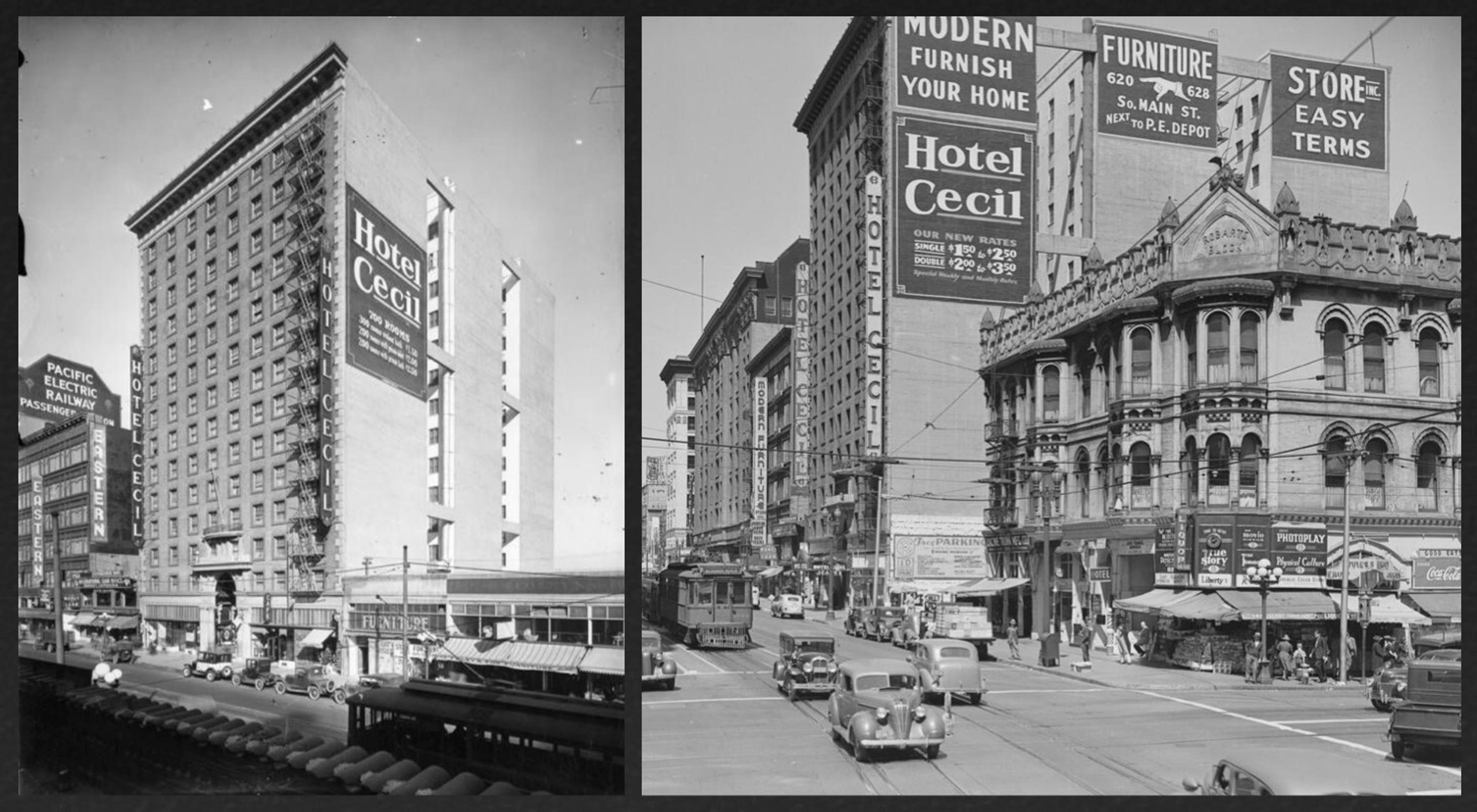Hotel Cecil Whitewash, Part II
For Part I, click here.
Let me be clear. I’m not mad at the developer. The developer was only doing what developers do. They’ve got an ROI to look after.
Where the story goes sideways is all on our end. The Office of Historic Resources was given materials by the developer with which to determine the validity of painting over the eighty-year-old sign. Let’s look at them.
But first, let’s understand the basics:
There were two versions of the sign. The first sign was painted soon after the building opened, in 1924. It looked like this:
Ca. 1927 and 1938
Then the sign was repainted about 1940 (most likely, when the Cecil became part of the Alberts Hotel chain in early 1941). It looked like this:
The Office of Historic Resources was provided material, however, indicating that the _first_ version was the only one that mattered. That the red sign, pictured above, which had towered over Main Street for the last eighty-some years, had no historic value or meaning. From the evidence presented to OHR, it could be argued, that sign didn’t even exist.
Now, let’s look at the material presented to OHR, for example, this report:
And specifically, this page of said report:
Not 1940s, not looking south, but, nice use of all caps
While there are numerous contemporary shots of the Cecil throughout the Historic Consultants report, there are _none_ showing the just-painted-over 1940s wall signage. Why then did HC only include shots of the first version of the signage? They utilize images from the 1930s to do so. Which they mysteriously label 1940s. (A close look at the license plates reveal these images were captured in 1939—there’s no excuse for such a rookie mistake.) I won’t even go into the fact that that second shot doesn’t look south on Main, but north—all that may be just basic incompetence, but disincluding the historic Cecil signage in general is just…wrong.
Now then, let’s look at the other paperwork OHR used in their “not historic” determination.
Again, note its cover page (with “precedent imagery”) includes _four_ images of the initial 1924-1940 sign. Again, zero shots of what Simon Baron actually painted over, after OHR’s blessing:
This was done despite this wall sign specifically being called out in the Historic-Cultural Monument paperwork:
Thus, we have a character-defining feature of an HCM removed without review; the matter never went to commission and was never permitted. The Cecil is Mills Act so the removal was—money being fungible—paid for by tax savings intended only for work performed under the highest scrutiny vis-à-vis the Secretary of the Interior’s Standards for the Treatment of Historic Properties and the California Historical Building Code.
But at the end of the day, despite its documented importance, OHR determined the eighty-year-old sign was not historic and signed off on its whitewashing in place of modern advertising. This is our doing. And it has to stop.
About Nathan Marsak
NATHAN MARSAK says: “I came to praise Los Angeles, not to bury her. And yet developers, City Hall and social reformers work in concert to effect wholesale demolition, removing the human scale of my town, tossing its charm into a landfill. The least I can do is memorialize in real time those places worth noting, as they slide inexorably into memory. In college I studied under Banham. I learned to love Los Angeles via Reyner’s teachings (and came to abjure Mike Davis and his lurid, fanciful, laughably-researched assertions). In grad school I focused on visionary urbanism and technological utopianism—so while some may find the premise of preserving communities so much ill-considered reactionary twaddle, at least I have a background in the other side. Anyway, I moved to Los Angeles, and began to document. I drove about shooting neon signs. I put endless miles across the Plains of Id on the old Packard as part of the 1947project; when Kim Cooper blogged about some bad lunch meat in Compton, I drove down to there to check on the scene of the crime (never via freeway—you can’t really learn Los Angeles unless you study her from the surface streets). But in short order one landmark after another disappeared. Few demolitions are as contentious or high profile as the Ambassador or Parker Center; rather, it is all the little houses and commercial buildings the social engineers are desperate to destroy in the name of the Greater Good. The fabric of our city is woven together by communities and neighborhoods who no longer have a say in their zoning or planning so it’s important to shine a light on these vanishing treasures, now, before the remarkable character of our city is wiped away like a stain from a countertop. (But Nathan, you say, it’s just this one house—no, it isn’t. Principiis obsta, finem respice.) And who knows, one might even be saved. Excelsior!””
Nathan’s blogs are: Bunker Hill Los Angeles, RIP Los Angeles & On Bunker Hill.
